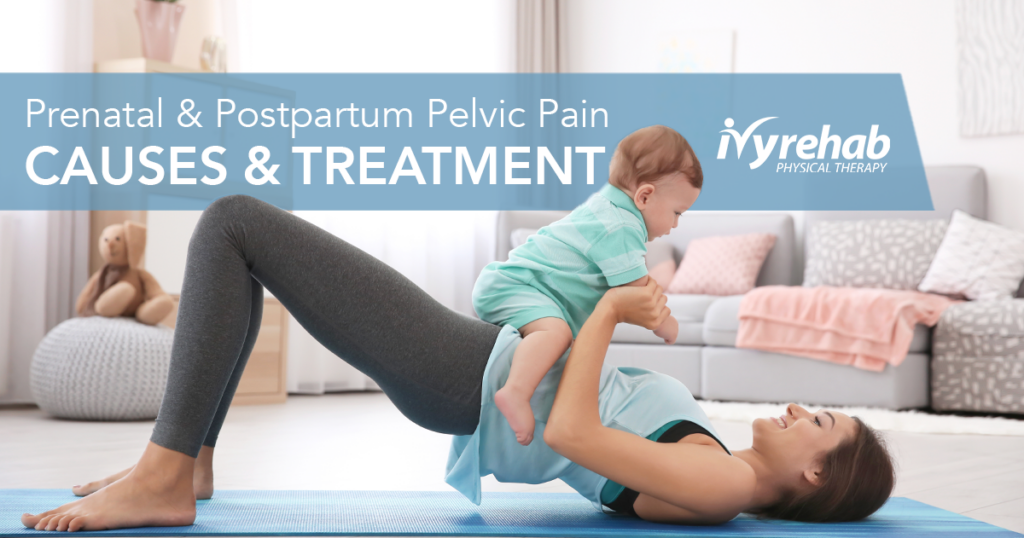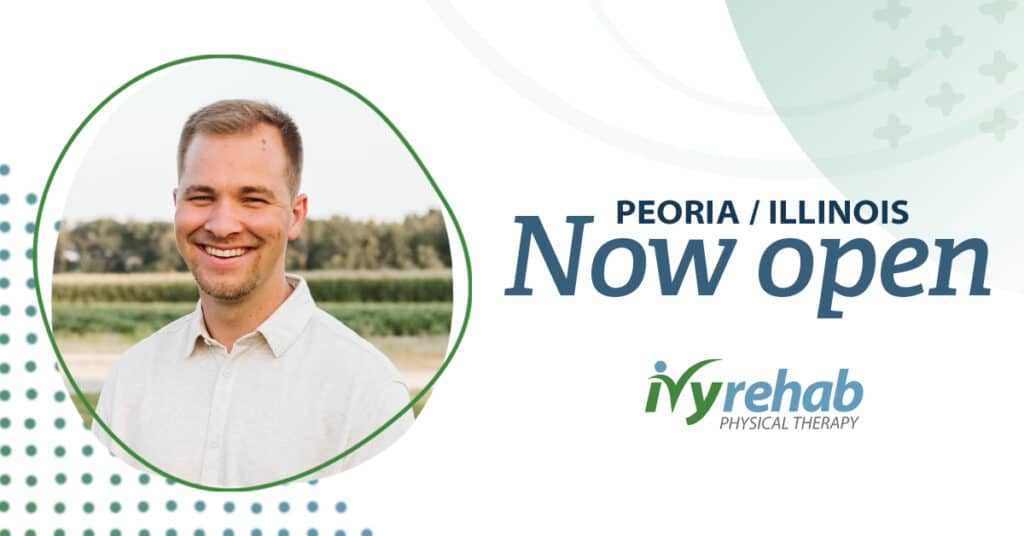You’ve just had your 6-week postpartum check-up with your OB. Everything looks great! You are given the green light to resume all activity. Prior to getting pregnant, you used to be an avid runner, so you decide to go for a “short” 3 mile run. After about 5 minutes in, you begin to experience sharp shooting pain in your groin. You decide to wait a few more weeks and then try again.
The same symptoms occur, only worse. What is happening? You thought 6-8 weeks would be enough time to get back to feeling like yourself. This is a common scenario that many women encounter after having a baby. If you’re wondering how to help pelvic pain after birth, there are several effective strategies and treatment options to consider. Described below are common causes of pelvic floor issues during pregnancy and postpartum, and some things you can do to help!
What causes pelvic pain during pregnancy?
It is important to understand the causes of aches and pains during pregnancy to understand postpartum pelvic girdle pain. Throughout various stages of pregnancy, hormonal changes occur that create increased elasticity of pelvic girdle ligaments. This is the body’s natural way of preparing for childbirth. However, increased laxity and stress on the joints of the pelvic girdle can result in pain and inflammation.
Muscle imbalances also begin to occur as the baby grows and the mother’s body changes. A growing belly can lead to increased curvature of the low back, a tilted pelvis, and increased tension in the upper back. This may result in muscle spasms, groin/hip pain, nerve compression, and sciatica.
Another common culprit of persistent pelvic pain during pregnancy is increased pressure on pelvic floor musculature. As the pelvic girdle prepares for giving childbirth, changes in pelvic floor musculature also occur. There is growing intra-abdominal pressure that increases stress on the pelvic floor muscle. This can present as persistent pelvic pain, lower abdominal pressure, vaginal pain, and even fecal incontinence or urinary incontinence/leakage.
What causes pelvic pain after delivery?
Every woman experiences some degree of pain and discomfort after vaginal or cesarean delivery, but how long does postpartum pain last? And when should you worry about postpartum pelvic pain? The answers can vary for each individual. Let’s take a look at the most common, treatable causes of postpartum pelvic pain.
Perineal tear
In general, women are advised to wait 6 weeks to allow for the healing of tearing from vaginal delivery or episiotomy. However, every woman heals at their own rate and 6 weeks is only a guideline. It is very common for this area to have perineal pain or tenderness and reduced mobility. The larger and deeper the perineal tear, the more time and possibly additional treatment, one may need prior to resuming full activity.
Muscle weakness/imbalance
As previously described, overstretching of abdominal muscles and instability of the pelvis can lead to discomfort during pregnancy. These changes don’t reverse immediately or automatically after delivery. The imbalance took 9 months to develop and can take just as long or longer to return to pre-pregnancy state.
Injury to pelvic floor musculature or abdominal musculature
Damage to pelvic floor or abdominal muscles during delivery can make it more difficult to lift, bend, carry, use the bathroom, and affect general mobility. Often, additional treatment, including scar massage and gentle strengthening, is required to return to the prior state.
Separation of pubic bones
This is a normal part of pregnancy and delivery, allowing for the baby to pass through the birthing canal. However, excessive separation can lead to increased movement of the pubic bone and inflammation or pain in the pubic area.
Pelvic organ prolapse
This occurs when pelvic floor musculature is not working efficiently enough to support internal organs, such as bladder, uterus, or rectum. Prolapse of pelvic organs may lead to feelings of heaviness, pain, or bulging in the pelvis or vagina.
How to relieve pelvic pain during and after pregnancy
To mitigate pain, there are a variety of tactics that may help both during and after your pregnancy.
Breathing
Seems simple right? Often, the pelvic floor muscle is holding increased tension and stress. Find a comfortable position, either laying on your back or slightly reclined. Rest your hands on your belly. Inhale and fill your belly up with air, imagine a balloon expanding in your lower abdomen. Exhale and allow the abdomen to lower back down to neutral. Throughout this breathing exercise, there should be a developing awareness of pelvic muscles lengthening and relaxing.
Body Mechanics
There are so many new things to lift and carry after having a baby! The baby itself, a car seat, a stroller, etc. Here are some tips for the unavoidable heavy lifting that will ensue:
- Tighten deep abdominal muscles by drawing the belly button in towards spine. This will help protect low back and engage pelvic floor musculature.
- Keep objects close to your body. Whether you are reaching for the diaper bag, or trying to lift the baby out of the crib, getting as low and as close to the object as possible will reduce strain on low back.
- Bend your knees. Even though it will become increasingly difficult with a growing baby (during pregnancy and postpartum), using leg muscles to squat, push, and lift will help minimize strain on the lower back and pelvic region.
Gentle Strengthening
Similar to pelvic floor exercises for men can help their own pelvic floor dysfunction, the same is true for women. Begin to activate muscles that will help stabilize the pelvic area during pregnancy and after delivery.
- Engage each pelvic floor muscle by squeezing and lifting muscles around the vagina as if you were trying to stop the flow of urine.
- Contract glute muscles simply by squeezing your buttocks together.
- Activate deep abdominal muscles by exhaling and pulling your belly button in towards your spine.
External Support
Sometimes, our own muscles need a boost. Wearing an SI support belt during pregnancy or after delivery can provide the pain relief we need until our own muscles are strong enough to stabilize the pelvic girdle.
Posture
As your body changes during and after pregnancy, posture is key to minimizing tension in the lower and upper back. Neck and shoulders should be relaxed. Utilize back support when able, especially while breastfeeding. Engage glut and deep abdominal muscles with prolonged standing to help reduce excessive curvature of the lower back and your pelvic bone.
How long does it take for pelvic pain to go away after giving birth?
The duration of pelvic pain varies for each individual. While some women may find relief within a few weeks, others may experience discomfort for several months. Recovery time depends on factors like the extent of muscle strain, any injuries sustained during delivery, and the individual’s overall health and fitness level.
Combat pelvic pain with physical therapy
In summary, low back, hip and pelvic girdle pain, is extremely common during and after pregnancy. Symptoms are often brushed off as a normal side effect of pregnancy and delivery, and women are left in chronic pelvic pain with minimal guidance on how to relieve symptoms.
In many cases, pain relief can be obtained with gentle pelvic floor exercise, education on the causes of pain, and improved body mechanics. Don’t let pelvic floor pain negatively affect the life-changing experience of pregnancy and giving birth. There are physical therapists who specialize in pregnancy, postpartum pain, and pelvic health who can provide effective pain management and help you get back to feeling good again!
Listed below are common diagnoses that can be helped with pelvic floor physical therapy:
- Pubic symphysis dysfunction
- SI Joint dysfunction
- Tailbone pain
- Diastasis Recti
- Pelvic organ prolapse
- Fecal incontinence
- Urinary incontinence
- Sciatica
- Pubic bone pain
- Vaginal pain
If you’re experiencing chronic pain, don’t hesitate to find a pelvic floor physical therapist to help relieve your abdominal pain. Ivy Rehab Network has over 400 physical therapy clinics dedicated to providing exceptional care and personalized pelvic floor treatment to get you feeling better, faster. Contact us today to learn more.
Article by Stephanie Calefati Guerra, PT, DPT
Stephanie Calefati Guerra, PT, DPT Ivy Rehab Downtown Hoboken, NJ
Stephanie graduated from Northeastern University with a Doctorate in Physical Therapy in 2010. Her interest in physical therapy, anatomy, and working with athletes developed over the course of many years as a gymnast. She has always had a special interest in rehabilitation for returning young athletes to prior level of performance. As a Pose Certified Running Technique Specialist, she has helped countless runners complete races, recover from injuries, and improve technique. More recently, after giving birth to her 2 babies, her interest in pelvic floor rehabilitation developed. She completed training through Herman and Wallace Pelvic Rehabilitation Institute and looks forward to helping women treat all ranges of pelvic floor related issues. She combines her previous experience with athletes with current pelvic floor training, to help women return to full prior level of fitness and athletic function. She strives to spread awareness and education on pelvic floor rehabilitation and to raise the standard of care for pregnant and postpartum women.
Education:
- Bachelor of Science in Rehabilitation Science
- Doctorate of Physical Therapy
- Herman and Wallace Pelvic Rehabilitation Institute
- Pose Certified Running Technique Specialist
The medical information contained herein is provided as an information resource only, and does not substitute professional medical advice or consultation with healthcare professionals. This information is not intended to be patient education, does not create any patient-provider relationship, and should not be used as a substitute for professional diagnosis, treatment or medical advice. Please consult with your healthcare provider before making any healthcare decisions or for guidance about a specific medical condition. If you think you have a medical emergency, call your doctor or 911 immediately. IvyRehab Network, Inc. disclaims any and all responsibility, and shall have no liability, for any damages, loss, injury or liability whatsoever suffered as a result of your reliance on the information contained herein.





